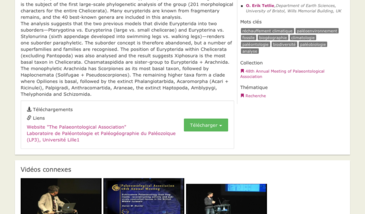En ligne depuis le 01/01/2008
0/5 (0)

Description
The monophyletic Palaeozoic chelicerate order Eurypterida, contains around 65 genera and is the subject of the first large-scale phylogenetic analysis of the group (201 morphological characters for the entire Chelicerata). Many eurypterids are known from fragmentary remains, and the 40 best-known genera are included in this analysis. The analysis suggests that the two previous models that divide Eurypterida into two suborders—Pterygotina vs. Eurypterina (large vs. small chelicerae) and Eurypterina vs. Stylonurina (sixth appendage developed into swimming legs vs. walking legs)—renders one suborder paraphyletic. The suborder concept is therefore abandoned, but a number of superfamilies and families are recognised. The position of Eurypterida within Chelicerata (excluding Pantopoda) was also analysed and the result suggests Xiphosura is the most basal taxon in Chelicerata. Chasmataspidida are sister-group to Eurypterida + Arachnida. The monophyletic Arachnida has Scorpiones as its most basal taxon, followed by Haplocnemata (Solifugae + Pseudoscorpiones). The remaining higher taxa form a clade where Opiliones is basal, followed by the extinct Phalangiotarbida, Acaromorpha (Acari + Ricinulei), Palpigradi, Anthracomartida, Araneae, the extinct Haptopoda, Amblypygi, Thelyphonida and Schizomida.
État
- Valorisé
Langues
- Anglais
Licence Creative Commons
- Partage des conditions à l'identique
- Pas d'utilisation commerciale
- Pas de modification
- Paternité
Nature pédagogique
- Cours
Niveau
- Bac+5
Types
- Grain audiovisuel

